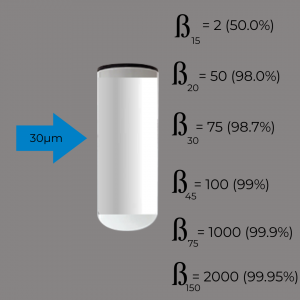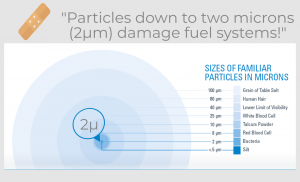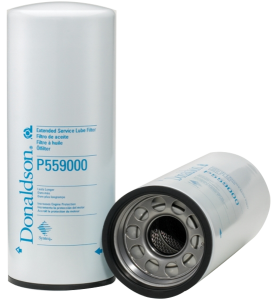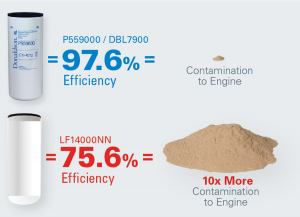If a filter is rated as absolute, would you guess it is a good thing? If you guessed “yes” (in some cases), you may have to guess again… Let’s explain:
Filtration terms like absolute and nominal can be pretty confusing. In fact, some filtration companies use them in their marketing to mask the technical specifications of their filters from the specifications of their competitors. In the Donaldson Language of Filtration series, Bergey’s Truck Centers and Donaldson Filtration are here to help make these terms easy to understand so you can make the right choice for your fleet maintenance needs. If you joined us for our first part of the Language of Filtration, you learned about Beta Ratio, Micron Ratings and Efficiency. If you didn’t, please check out that article first as it contains information you need for this one!
In this article, we will take a closer look at how all of these terms are used in the marketing of filtration products for the heavy-duty diesel industry. At Bergey’s Truck Centers, we believe that our brand promise of Keeping Customers on the Road™ begins with a promise to use our expertise and provide honest, up-front and factual information to the consumer on any facet of the transportation business.
In our previous article, we discussed Beta Ratio and Efficiencies role in selecting the proper filtration for your application. There are other filter ratings that we would like to talk about to help alleviate any confusion and to shed some light on how disinformation is used in filtration marketing, often to the disadvantage of the consumer.
| Beta Ratio | Efficiency | Particles Passed vs. Particles Captured |
|---|---|---|
| 2000 | 99.95% | 1 out of 2000 |
| 1000 | 99.90% | 1 out of 1000 |
| 200 | 99.50% | 1 out of 200 |
| 100 | 99.00% | 1 out of 100 |
| 75 | 98.70% | 1 out of 75 (ABSOLUTE) |
| 50 | 98.00% | 1 out of 50 |
| 2 | 50.00% | 1 out of 2 (NOMINAL) |
As you can see on the chart, a filter rated absolute is 98.70% efficient, capturing only 1 out of 75 particles for the micron rating. The reason why most people get confused is that the term absolute makes the filter sound as if it is 100% efficient when in fact it is not. Their term absolute is based on an old way of efficiency testing that was not as accurate as today’s modern standard. Back then, absolute did mean 100%, but not anymore!
Another confusing term is nominal. A filter with a nominal rating of 8µm nominal means that it is only 50.00% efficient on 8µm particles.
But, these terms have hung around in the industry for years, and filtration manufacturers have used them in order to give the perception that they meet the same specifications as their competition.
Filters are typically rated to one micron size when you pull up a spec sheet or look at it in a catalog. But actually, when companies perform a test on a filter, they get a lot of data. And, it is important to understand the way test standards are written. Test standards will tell the filter manufacturer how to set up a test, perform the test, and collect the data. Beyond that, it is up to the filter manufacturer to decide how they want to advertise the performance of the filter. This is why it is important to understand filter language.

Here is an example of a fuel dispenser filter rated at “30 microns absolute.” It is typically used in truck stops inside the fuel pump. It is not a very efficient filter, in fact, it is only designed to protect the metering of the pump, and not a diesel engine. But how might this filter protect the vehicle from other, potentially smaller particles?
As you can see, the efficiency of this filter changes quite a bit depending on the size of the particle. So the data from the test determines how the manufacturer will market it. But being labeled as “30 microns absolute” leaves the impression that this is a highly efficient filter, when in fact, it is not.
In our last article, we used a chicken coop as a way to better understand how a filter is designed to perform. So to get the point across, we are going back to the fences to translate this into something relatable.
Let’s say that you have a chain-link fence around your yard, and your neighbor’s kid is an excellent baseball player with a really strong arm.
Let’s rate this fence on its ability to stop contaminant that the neighbor’s kid throws at it. So we are going to treat the fence like a filter and perform our own lab test on it.



First we give him some baseballs (11µm), and for every 75 baseballs he throws, 1 makes it through the fence by squeezing underneath the fence where the chain link meets the grass. If we were treating the fence like a filter, we would call the fence “Baseball Absolute.”
Golf balls (7µm)? About half of the golf balls went through the fence, then we could call the fence “Golf Ball Nominal.” Marbles (4µm)? Well, nearly all the marbles went through. At the end of the exercise, there might not have been a lot of baseballs in your yard, but there was still a mess to clean up before someone slipped and fell! The same concept applies to your diesel engine. Particles that are 2-6µm in size are what are wearing out modern high-pressure-common-rail diesel injectors!
Now let’s say that there is a competitor who makes a six-foot-tall, wood privacy fence. And this fence is advertised with a 99.95% efficiency rating of stopping baseballs. That’s a Beta Ratio of 2000! Based on this, how do you think the Chain Link Company would advertise their fence? They certainly can’t advertise its efficiency (98.70%), because it is not as good as 99.95%! So they use baseball absolute in their marketing. Technically, the chain-link fence being called absolute is not incorrect, but the average consumer may think that the term absolute means that all baseballs are filtered by the fence when it is only 98.70%.

Now, let’s apply what we’ve learned to a real scenario with actual filters. Let’s take a look at two filters for a Cummins ISX engine. One is advertised with a rating of 99% at 30µm, and the other is rated at 97.6% at 15µm.
This is the Donaldson Filtration filter datasheet for the Cummins ISX application. You will see that it is rated at 97.6 efficiency at 15µm. Some consumers might look at the efficiency rating (%) of the filter without paying attention to the micron size to which it is being compared. Yes, the Donaldson filter has a lower percentage, but for particles that are half the size of the competitor.
| Attributes | |
|---|---|
| Efficiency 97.6% | 15 micron |
| Outer Diameter | 4.65 inch (118 mm) |
| Thread Size | M95 x 2.5 |
| Length | 11.69 inch (297 mm) |
| Gasket OD | 4.69 inch (119 mm) |
| Gasket ID | 4.02 inch (102 mm) |
| Efficiency Test Standard | ISO 4548-12 |
| Media Type | Synteq |
| Type | Full-Flow |
| Style | Spin-On |
| Media Brand | Synteq™ |


Take a look at the difference in contamination of 15µm between the filter rated 97.6% 15µm efficient, versus one that is rated 99% 30µm!
So when it comes to the language of filtration, understanding all of these terms and how they inter-relate to one another plays an important role in determining the proper filtration for your application with an efficiency rating that stops the smallest size contaminants as possible for maximum uptime.